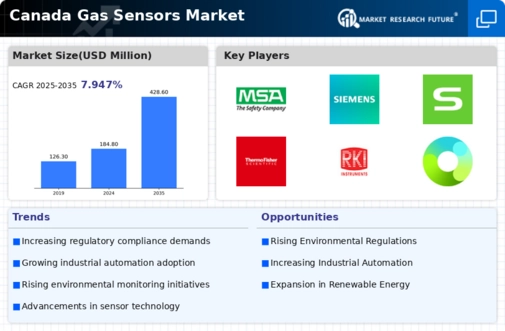Rising Industrial Demand
The gas sensors market in Canada is experiencing a notable surge in demand driven by various industrial sectors. Industries such as oil and gas, manufacturing, and chemical processing are increasingly adopting gas sensors to ensure safety and compliance with environmental regulations. The market is projected to grow at a CAGR of approximately 7.5% from 2025 to 2030, reflecting the critical need for real-time monitoring of hazardous gases. This trend is further supported by the Canadian government's initiatives to promote industrial safety and environmental sustainability. As industries expand, the reliance on advanced gas detection technologies becomes paramount, thereby propelling the gas sensors market forward.
Emerging Smart Technologies
The integration of smart technologies into the gas sensors market is transforming the landscape of gas detection in Canada. Innovations such as IoT-enabled sensors and advanced data analytics are enhancing the functionality and efficiency of gas monitoring systems. These smart sensors provide real-time data, enabling proactive measures to mitigate risks associated with gas leaks. The market for smart gas sensors is expected to witness a growth rate of around 8% annually, as industries seek to leverage technology for improved safety and operational efficiency. This shift towards smart solutions is likely to redefine the gas sensors market, making it more responsive to the needs of various sectors.
Government Initiatives and Funding
Government initiatives aimed at enhancing public safety and environmental protection are significantly influencing the gas sensors market in Canada. Various funding programs and grants are available to support the adoption of advanced gas detection technologies across multiple sectors. For instance, the Canadian government has allocated approximately $50 million to promote research and development in environmental monitoring technologies, including gas sensors. This financial backing encourages businesses to invest in state-of-the-art gas detection systems, thereby expanding the market. As regulatory frameworks evolve, the gas sensors market is likely to benefit from increased government support and funding opportunities.
Increased Focus on Occupational Health and Safety
The heightened emphasis on occupational health and safety in Canada is a key driver for the gas sensors market. Organizations are increasingly recognizing the importance of protecting workers from hazardous gas exposure, leading to a surge in the adoption of gas detection systems. The market is projected to expand by approximately 7% annually as companies invest in safety measures to comply with stringent regulations. This focus on worker safety not only enhances employee well-being but also mitigates potential liabilities for businesses. Consequently, the gas sensors market is likely to thrive as organizations prioritize health and safety in their operational frameworks.
Growing Urbanization and Infrastructure Development
Urbanization in Canada is driving the need for enhanced safety measures, particularly in densely populated areas. The gas sensors market is poised to grow as cities expand and infrastructure projects increase. With more construction activities and urban development, the demand for gas detection systems in residential, commercial, and industrial settings is on the rise. It is estimated that the market could grow by 6% annually as municipalities prioritize safety and environmental monitoring. This trend underscores the importance of integrating gas sensors into urban planning and development strategies, thereby fostering a safer living environment.



















Leave a Comment